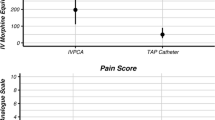Abstract
Purpose
‘Hockey stick incision’ used in renal transplant is large enough to cause severe postoperative morbidity especially in pediatric recipients. Although epidural analgesia is known to be effective in pain control, the resulting sympathectomy might affect hemodynamics interfering with the transplant process. In our study, we evaluated the feasibility and safety of inserting an epidural catheter to the thoracic level via the caudal route, and the effect of using epidural local anesthetics at low concentrations on hemodynamics.
Methods
After approval from the ethical committee at Kasr Al Ainy University Hospital and consent from parents/legal guardians, sixty patients aged 3–12 years who were scheduled for renal transplant were randomly divided into two equal groups. Group I (epidural group) received continuous caudal epidural bupivacaine 0.125 % with fentanyl together with intravenous (IV) fentanyl and paracetamol. Group II (control group) received only IV fentanyl and paracetamol. Intraoperative data included heart rate (HR), mean arterial blood pressure (MAP) and central venous pressure (CVP). Postoperative variables included HR, MAP, CVP, pain score and complications.
Results
Threading failure via the caudal route occurred in 6.67 % of cases. Intraoperative differences in hemodynamics and CVP were not clinically significant between groups. Postoperative HR, MAP, and CVP were generally higher in the control group. Pain control was more satisfactory and postoperative complications were less in the epidural group.
Conclusion
Caudal epidural anesthesia in pediatric renal transplant is a valuable addition to general anesthesia as it provides stable perioperative hemodynamics, excellent postoperative analgesia and is associated with fewer complications than narcotic-dependent analgesia.
Clinical trial registration number: NCT02037802



Similar content being viewed by others
References
Peutrell JM, Mather SJ. Regional anaesthesia for babies and children. Oxford: Oxford University Press; 1997. p. 187–233.
Rowney DA, Doyle E. Epidural and subarachnoid blockade in children. Anaesthesia. 1998;53:980–1001.
Tobias JD, Lowe S, O’Dell N, Holcomb GW 3rd. Thoracic epidural anaesthesia in infants and children. Can J Anaesth. 1993;40:879–82.
Flandin-Blety C, Barrier G. Accidents following extradural analgesia in children. The results of a retrospective study. Pediatr Anaesth. 1995;5:41–6.
Kasai T, Yaegashi K, Hirose M, Tanaka Y. Spinal cord injury in a child caused by accidental dural puncture using a single-shot thoracic epidural needle. Anesth Analg. 2003;96:65–7.
Gunter JB, Eng C. Thoracic epidural anesthesia via the caudal approach in children. Anesthesiology. 1992;76:935–8.
Hannallah RS, Broadman LM, Belman AB, Abramowitz MD, Epstein BS. Comparison of caudal and ilioinguinal/iliohypogastric nerve blocks for control of post orchiopexy pain in pediatric ambulatory surgery. Anesthesiology. 1987;66:832–4.
Shah VR, Butala BP, Parikh GP, Vora KS, Parikh BK, Modi MP, Bhosale GP, Mehta T. Combined epidural and general anesthesia for pediatric renal transplantation-a single center experience. Transplant Proc 2008;40(10):3451–4. doi:10.1016/j.transproceed.2008.06.065.
Dauri M, Costa F, Servetti S, Sidiropoulou T, Fabbi E, Sabato AF. Combined general and epidural with ropivacaine for renal transplantation. Minerva Anestesiol. 2003;69:873–84.
Bösenberg AT, Bland BA, Schulte-Steinberg O, Downing JW. Thoracic epidural anesthesia via caudal route in infants. Anesthesiology. 1988;69:265–9.
Rasch D, Webster D, Pollard TG, Gurkowski MA. Lumbar and thoracic epidural analgesia via the caudal approach for postoperative pain relief in infants and children. Can J Anaesth. 1990;37:359–62.
Bhandal N, Rogers R, Berg S, Mason DG. Paediatric caudal extradural catheterisation: an evaluation of a purpose designed equipment set. Anaesthesia. 2006;61:277–81.
Blanco D, Llamazares J, Rincón R, Ortiz M, Vidal F. Thoracic epidural anesthesia by the caudal route in pediatric anesthesia: age is a limiting factor. Rev Esp Anestesiol Reanim. 1994;41(4):214–6.
Blanco D, Llamazares J, Rincón R, Ortiz M, Vidal F. Thoracic epidural anesthesia via the lumbar approach in infants and children. Anesthesiology. 1996;84:1312–6.
Author information
Authors and Affiliations
Corresponding author
Ethics declarations
Conflict of interest
No conflicts of interest declared.
Implication statement
Epidural analgesia is known to provide balanced anesthesia in adult renal transplant when combined with general anesthesia. This article sheds light on the feasibility of catheter threading through the caudal route to a lower thoracic level in pediatrics subject to renal transplant and whether it negatively affects hemodynamics interfering with the transplant procedure.
About this article
Cite this article
Soaida, S.M., ElSheemy, M.S., Shouman, A.M. et al. Caudal extradural catheterization in pediatric renal transplant and its effect on perioperative hemodynamics and pain scoring: a prospective randomized study. J Anesth 30, 47–54 (2016). https://doi.org/10.1007/s00540-015-2087-8
Received:
Accepted:
Published:
Issue Date:
DOI: https://doi.org/10.1007/s00540-015-2087-8




